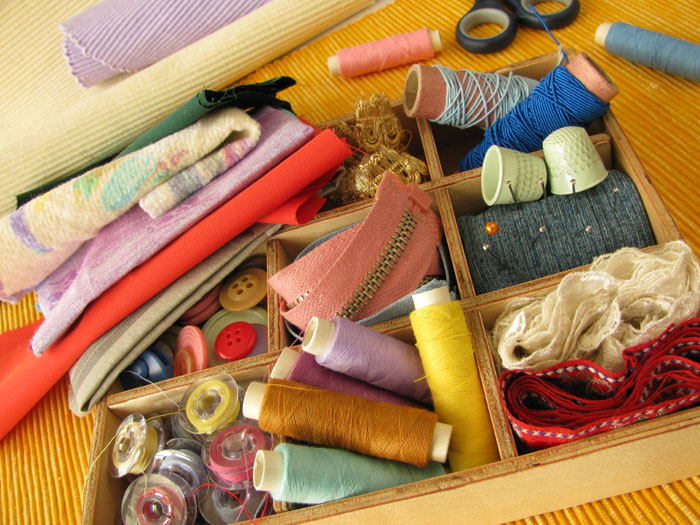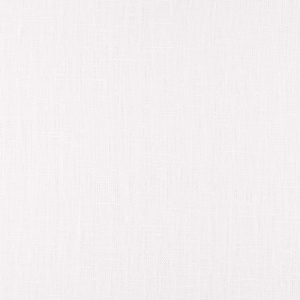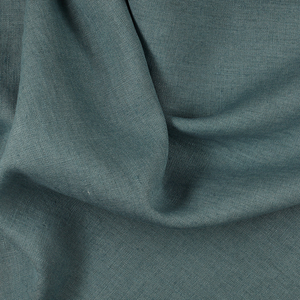Sewing Tips: Tricky Organization
I moved about a year ago and had to leave most of my sewing collection behind. I’ve slowly been building my collection back up over time, and while “œtoo much fabric” isn’t something I would classify as a “œproblem”, figuring out how to organize it all is.
When I get really into my sewing projects, sometimes my collection of sewing goodies can look like a tornado hit it. With a large collection of fabric, pins, needles, notions, and patterns – it’s easy to find yourself lost amongst a pile of sewing supplies. I’ve come across some really amazing organizational ideas that I’ve put into use over the years, and I hope these will help you out too.
Mason Jar Pin Cushion
This probably just looks like a blatant self-promotion (and it kind of is, click here to check out the tutorial), but this is an excellent way to organize your smaller notions. Buttons, snaps, grommets, bobbins, small cuts of lace or ribbon, tiny ribbon roses that could otherwise be lost in your collection can be found quickly by storing in small mason jars. Also, you can mount a pin cushion on top and transformthis jar into a multi-use tool, making it more than just a convenient storage accessory.
Really Useful Box
There is a tiny little plastic bin with a lid and side hinges that you can buy at Staples for $1. The brand name is “œReally Useful Box” (you can check them out by clicking here). They’re small – perfect for notions, bobbins, paper clips, etc. – and they’re stackable! I am in love with them.
Not only are they small, stackable, durable, and adorable — but they’re also transparent. That means that you can find what’s inside them with just a glance. Despite being small, they actually hold quite a lot. While I’ve stuffed these with buttons, zippers, and fabric flowers, I have also used them for temporary storage. For example, I use them to hold items like pieces of fabric that I’ve already cut to size. Like I said, I love them — they’re just perfect for any sort of craft or organizational need.
They also come in all sorts of sizes. So they’re excellent for storing everything from your smallest notion to your larger bolts of fabric.
Plastic Zip Bags
Those little bags that you use to pack your kids’ lunches in and put your leftovers away with are one of the best organizational tools for your sewing and craft needs. They come in an assortment of sizes, from tiny jewelry size to comforter size, so you can safely pack, store, and organize all of your fabrics and notions.
The best thing about using plastic zip bags is that you can see exactly what you’re trying to find, even if you have several kept in the same bin. Just pull a couple bags out, find exactly what you need, put the rest away. Perfectly organized!
Plastic Storage Drawers
These small, desk-drawer organizers are actually the perfect height for most sewing thread spools. I used these for years and they were absolutely wonderful for storing thread spools, bobbins, scissors, my rotary cutter, or anything small that isn’t suitable for putting into plastic bags. (Click here for a link to one of the desk drawer sets that I’ve used for this purpose.)
Ribbon Dispenser
If you need an easy way to access your ribbon while keeping them neat and tidy, you can create your own ribbon dispenser. Simply slide your ribbon spools onto a wooden rod (to keep them lined up), and then just place it into a plastic storage bin that’s large enough to fit all of your spools. Follow this by cutting holes or notches into the lid of the storage bin. Finally, thread the ribbon through. Put the lid on the bin and you have a handy-dandy ribbon dispenser that keeps your ribbons organized. Just pull and cut the amount you need for your project.
Wooden dowels and curtain rod hooks
Another idea for organizing your ribbon spools is to use a wooden dowel hung on curtain rod hangers. They can be installed just about anywhere and will allow you to have easy access to all of your ribbons (or lace, or anything else you can store on it).
Storing fabric using Comic Book Boards
I saved the absolute best for last. You can store your smaller cuts of fabric by creating mini-bolts of fabric, using “œcomic book boards” (a cut of heavy weight cardstock used to keep comics from warping or bending when they’ve been bagged). Fold your fabric to the width of the board, and then wrap around the board as if it were a bolt.
This allows your smaller cuts of fabric to be put into bookshelves, or stored in bins in a way that is a lot easier to organize and access than just having it folded without anything to support it.
Comic book boards can be purchased online in bulk for very cheap, making it super economical as well as space saving. (Click here for a link to some comic book boards.)
Share how you organize your sewing supplies and fabric in the comments below!















































10 Comments
Sue Dickson
I store my ribon/trims that come on spools in vinyl house gutters. I cut three lengths of gutter to fit the wall near my sewing area, put tnd caps on each length, and mounted them on the wall with the plastic hangers you mount them on the house with. There is also room for my thread overflow, pincushion with hand sewing needles, and other items. I have lots of ribon because I do paper crafting as well as sewing-and I got tired of the spools unwinding when I had them on wooden dowels. This works much better.
My craft room is 1/3 the size of my craft room in our house in AK that we sold when we moved south. I had to downsize-and don’t have space left to store my remaining fabric stash-so 5 tote bins in the garage saved the day. I have repurposed an entertainment center, 3 LARGE desks, two file cabinets, a book case, a closet, and lots of rolling plastic drawer units to store all my ‘toys’. There are also open shelves on the walls. Old CD jewel cases hold my rubber stamps (all taken off the wood blocks) with labels on each and stacked in plastic bins on the shelves. A utility parts cabinet with drawers sits there too. I stopped saying my room is crowded-now it is cozy, and I can be productive here.
Liz Powell
I use Mason jars for ‘strung into sets’ of buttons; each jar has a specific colour or shade. Then smaller Jam jars that are also square for ‘Press Studs’, ‘Hooks and Eyes’ and so one; one jar for silver, another for black japaned ones. I did try cheap plastic sandwich boxes but the plastic broke down after a couple of years.
For Beads and Sequins and jewellery findings I bought a box (144 a Gross) of small push-on top Pill Vials; they lie head to tail in home-made card trays that fit them exactly and fit into an Egg Tray box.
I also bought some larger vials to take nuts, bolts, screws and suchlike in my workshop. Easier to find a #8 1″ Phillips head screw when they are sorted.
On my workbench I have a fairly large 1″ or so, Rare Earth Magnet to hold pins; no computerised machines here. I also have a cutter from a Dental Floss container crazy-glued to a button and to a small magnet as a portable thread snip. It also fits into a small “Extra Strong Mint” tin and acts as a holder for a couple of needles and pins, and makes it a portable sewing kit for any small projects. Sometimes the entire project fits in there; great for dental office waits and long journeys.
IKEA have paper tape measures; placed on the edge of your bench or table and covered with packing tape ( a two person job) you always have a handy measure, and two set end to end up a door frame or such act like the ones in Lumber Yards as a height measure or a rough and ready measure for lengths of trim-fabric-and so on.
Last of all, through-out my house are various tins that I have inherited, been given, and even bought for myself. One favourite always held my grandmothers darning supplies; a pair of scissors, 3 different shapes of Darning Mushrooms, one of which has a hollow screw-in handle to keep needles safe, and a mass of skeins, balls, and little wound onto cardboard hanks of wool, wool and nylon mix, “Lisle” and Darning Cotton yarns; ready to mend anything. Happy Memories.
Liz
Sharon
I love your dental floss cutter ideas! Genius!
Amelia
I love using canning jars and glass canisters for my sewing notions. They look so cheerful lined up on the shelf!
Martha Kemble
Our daughter and I have used small or large utility boxes with small drawers (bought at a hardware store) for keeping needles (both sewing), quilting and machine, rotary cutter blades, thimbles, pre-wound empty bobbins, and machine feet for embroidery, hemming and other things that come with your sewing machine. They are positioned on the sewing table for quick replacing of feet. Very handy. If large enough they should hold rotary cutters and scissors. They do keep things in order and right at hand for convenience.
Marlette Louisin
I love the metal small parts cabinets with clear plastic drawers that my husband uses in his woodworking shop. He uses them for different sizes of stews and such.
I have 3 of them and store pre wound bobbins, snaps and hooks, ribbon, special kinds of buttons, elastic, labels, etc. These can be hung on the wall or put on a shelf. I got mine in a big box home center.
Sharon
I have found that tins that used to hold loose tea are perfect for all kinds of things, too. They come in all sorts of sizes, they’re sturdy enough, they are always metal, and they’re really useful. A sample of Victoria’s blend came in a round lidded tin perfect for straight pins. A few tins from a home party seller make wonderful bins for spools of elastic and ribbon. Tea biscuit tins make a wonderful storage for thread spools. Constant Comment tins are wonderful for notions. They stack, they don’t break, and you don’t need to worry about packing them for moves!
Miriam
Fishing tackle boxes are AMAZING! and far cheaper than anything sold for sewing.
AmyB
I use old coffee cans with snap lids to hold my elastic. One can for each size elastic. I cut a slice in the lid where I feed the elastic through so it is easy to dispense. I cover with decorative contact paper and stack them on my shelving unit! Keeps the elastic clean and yet easy to find the correct size needed.
Michaela Smith
Amy, wow! That is so incredibly clever. I knew there was a good reason I’ve been saving my old coffee cans. Thank you for suggesting it!